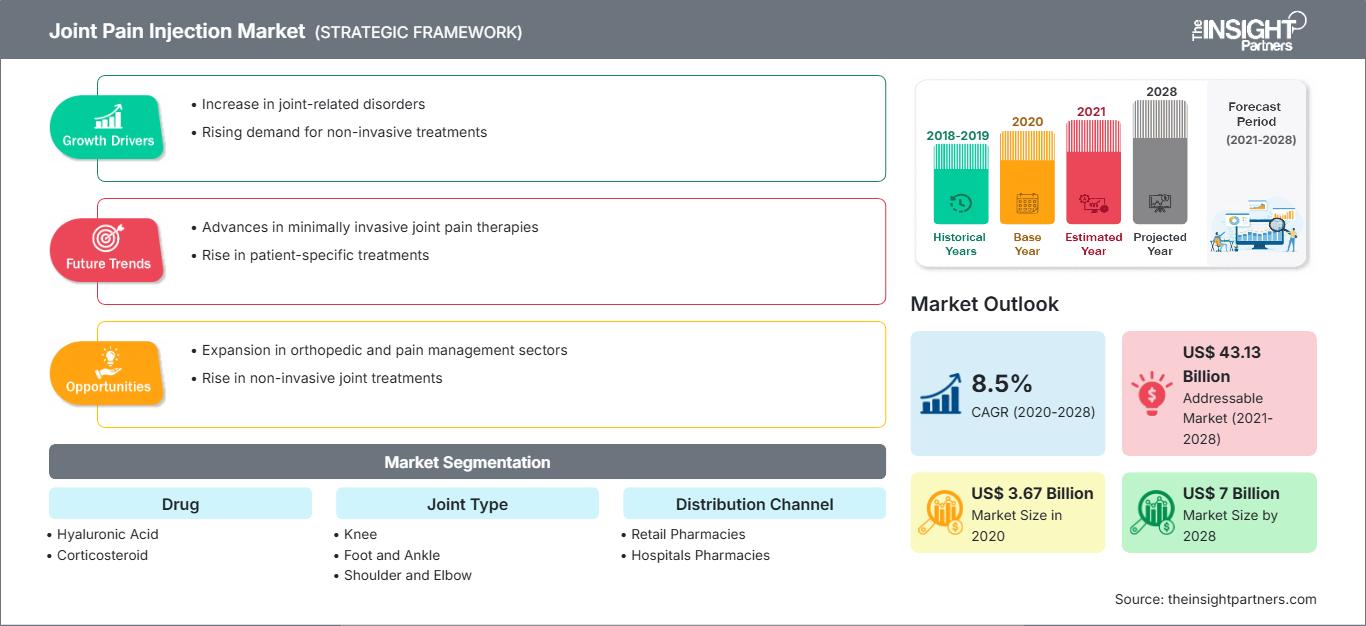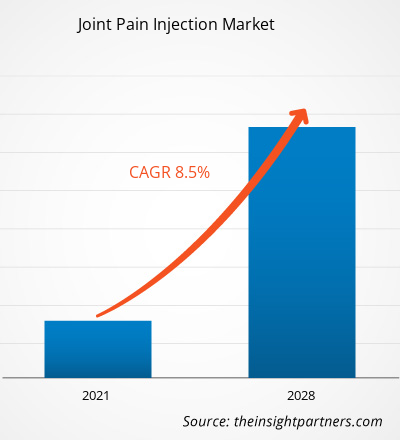[Rapport de recherche] Le marché des injections pour les douleurs articulaires devrait atteindre 6 996,88 millions de dollars américains d'ici 2028, contre 3 667,45 millions de dollars américains en 2020 ; sa croissance devrait atteindre un TCAC de 8,5 % entre 2021 et 2028.
Les injections pour les douleurs articulaires soulagent plus rapidement les douleurs intenses et réduisent l'inflammation des articulations. Plusieurs types d'injections sont disponibles sur le marché, notamment les injections de corticostéroïdes, d'acide hyaluronique (AH), de plasma riche en plaquettes (PRP) et de matrice tissulaire placentaire (PTM). La croissance du marché des injections pour les douleurs articulaires est attribuée à des facteurs tels que la forte prévalence des troubles musculo-squelettiques et le nombre croissant de blessures sportives. Cependant, les coûts élevés des thérapies de réparation articulaire freinent la croissance du marché.
Aperçu du marché
Forte prévalence des troubles musculo-squelettiques
Personnalisez ce rapport en fonction de vos besoins
Vous bénéficierez d’une personnalisation sur n’importe quel rapport - gratuitement - y compris des parties de ce rapport, ou une analyse au niveau du pays, un pack de données Excel, ainsi que de profiter d’offres exceptionnelles et de réductions pour les start-ups et les universités
Marché des injections pour les douleurs articulaires: Perspectives stratégiques

-
Obtenez les principales tendances clés du marché de ce rapport.Cet échantillon GRATUIT comprendra une analyse de données, allant des tendances du marché aux estimations et prévisions.
Les troubles musculosquelettiques sont des affections médicales affectant les muscles, les os et les articulations du cou, des épaules, des poignets, du dos, des hanches, des jambes, des genoux et des pieds. Ces maladies comprennent les tendinites, le syndrome du canal carpien, l'arthrose, la polyarthrite rhumatoïde (PR), la fibromyalgie et les fractures osseuses. Selon la fiche d'information de l'Organisation mondiale de la santé (OMS) mise à jour en 2018, les troubles musculosquelettiques sont la deuxième cause d'invalidité dans le monde. Selon cette même fiche, la prévalence et l'impact des troubles musculosquelettiques devraient augmenter avec le vieillissement de la population et l'augmentation de la prévalence des facteurs de risque de maladies non transmissibles (MNT) dans le monde. Selon les données de la réunion annuelle 2016 de l'American Academy of Orthopedic Surgeons, environ un adulte sur deux souffre d'un trouble musculosquelettique aux États-Unis. De plus, selon les Centres pour le contrôle et la prévention des maladies (CDC), l'arthrite provoque des douleurs intenses qui touchent des millions de personnes aux États-Unis chaque année. Environ un patient arthritique sur quatre, soit environ 15 millions sur un total d'environ 54 millions de patients, souffre de douleurs articulaires sévères liées à l'arthrite.
De plus, l'arthrose (OA) est l'une des maladies articulaires les plus courantes aux États-Unis, causée par la dégradation du cartilage articulaire entre les os. On l'appelle également maladie dégénérative des articulations ou arthrite d'usure. Selon les Centres pour le contrôle et la prévention des maladies (CDC), plus de 32,5 millions d'adultes aux États-Unis souffrent d'arthrose. De même, selon le Service national de santé (NHS), plus de 10 millions de personnes au Royaume-Uni souffrent d'arthrite ou d'autres affections similaires affectant les articulations. Selon Bupa Health Insurance, l'arthrose est la forme d'arthrite la plus répandue au Royaume-Uni. Elle touche environ un tiers des personnes âgées de 45 ans et plus, soit environ 8,75 millions de personnes. Par conséquent, la prévalence élevée des troubles musculo-squelettiques dans différents pays augmente le nombre de procédures de traitement, stimulant ainsi la croissance du marché des injections pour les douleurs articulaires.
Informations basées sur les médicaments
Le marché des injections pour les douleurs articulaires, par médicament, est segmenté en acide hyaluronique, corticostéroïdes et autres. Le segment des corticostéroïdes détenait la plus grande part de marché en 2020 et devrait enregistrer le TCAC le plus élevé au cours de la période de prévision.
Informations basées sur le type d'articulation
En fonction du type d'articulation, le marché des injections pour les douleurs articulaires est segmenté en genou, pied et cheville, épaule et coude, hanche et autres applications. Le segment du genou détenait la plus grande part de marché en 2020 et devrait enregistrer le TCAC le plus élevé du marché au cours de la période de prévision.
Injection pour les douleurs articulaires
Aperçu régional du marché des injections pour les douleurs articulaires
Les tendances régionales et les facteurs influençant le marché des injections pour les douleurs articulaires tout au long de la période de prévision ont été analysés en détail par les analystes de The Insight Partners. Cette section aborde également les segments et la géographie du marché des injections pour les douleurs articulaires en Amérique du Nord, en Europe, en Asie-Pacifique, au Moyen-Orient et en Afrique, ainsi qu'en Amérique du Sud et en Amérique centrale.
Portée du rapport sur le marché des injections contre les douleurs articulaires
| Attribut de rapport | Détails |
|---|---|
| Taille du marché en 2020 | US$ 3.67 Billion |
| Taille du marché par 2028 | US$ 7 Billion |
| TCAC mondial (2020 - 2028) | 8.5% |
| Données historiques | 2018-2019 |
| Période de prévision | 2021-2028 |
| Segments couverts |
By Médicament
|
| Régions et pays couverts |
Amérique du Nord
|
| Leaders du marché et profils d'entreprises clés |
|
Densité des acteurs du marché des injections pour les douleurs articulaires : comprendre son impact sur la dynamique commerciale
Le marché des injections pour les douleurs articulaires connaît une croissance rapide, portée par une demande croissante des utilisateurs finaux, due à des facteurs tels que l'évolution des préférences des consommateurs, les avancées technologiques et une meilleure connaissance des avantages du produit. Face à cette demande croissante, les entreprises élargissent leur offre, innovent pour répondre aux besoins des consommateurs et capitalisent sur les nouvelles tendances, ce qui alimente la croissance du marché.

- Obtenez le Marché des injections pour les douleurs articulaires Aperçu des principaux acteurs clés
- Analyse historique (2 ans), année de base, prévision (7 ans) avec TCAC
- Analyse PEST et SWOT
- Taille du marché Valeur / Volume - Mondial, Régional, Pays
- Industrie et paysage concurrentiel
- Ensemble de données Excel
Rapports récents
Témoignages
Raison d'acheter
- Prise de décision éclairée
- Compréhension de la dynamique du marché
- Analyse concurrentielle
- Connaissances clients
- Prévisions de marché
- Atténuation des risques
- Planification stratégique
- Justification des investissements
- Identification des marchés émergents
- Amélioration des stratégies marketing
- Amélioration de l'efficacité opérationnelle
- Alignement sur les tendances réglementaires






















 Obtenez un échantillon gratuit pour - Marché des injections pour les douleurs articulaires
Obtenez un échantillon gratuit pour - Marché des injections pour les douleurs articulaires